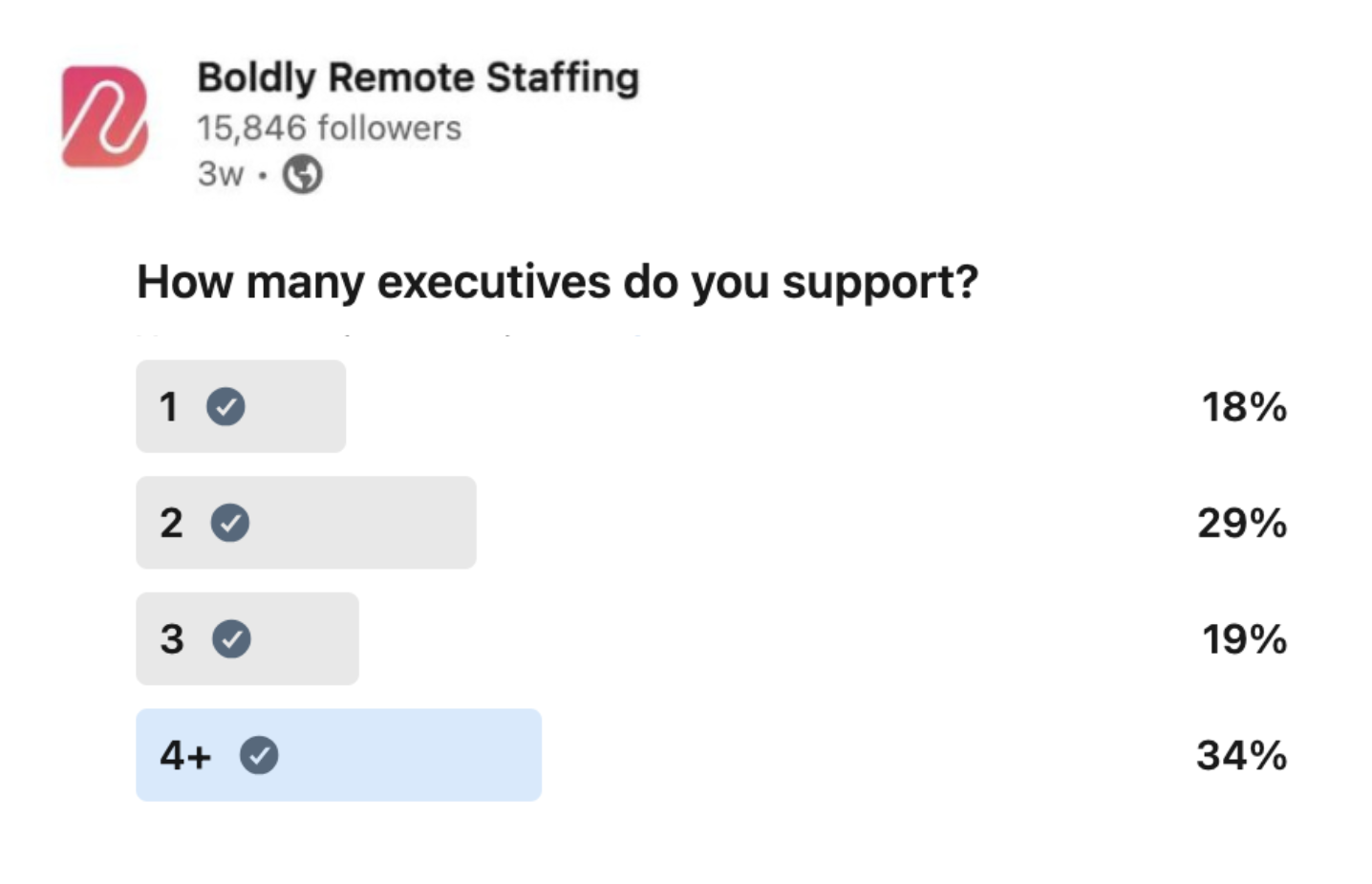There are fewer full-time executive assistants than ever before. And while the one-EA-to-one-executive model might be in decline, the amount of work expected of executives is not.
We recently asked Boldly’s LinkedIn community of executive assistants how many leaders they supported. Nearly 80% said they were regularly supporting two or more executives.


These numbers aren’t surprising.
Few executives would turn down an executive assistant, but most simply can’t justify a full-time hire. That’s why so many executives are turning to a shared executive assistant, but it requires everyone involved to be on the same page for:
- Effective communication
- Mutual collaboration
- Clear expectations
Here’s why and how it works.
Benefits Of Shared Executive Assistants
Let’s start with the basics — what is a shared executive assistant?
A shared EA is comparable to a fractional executive assistant; but instead of supporting multiple companies, the same assistant supports multiple executives within the same company.
This model is rising in popularity for good reason — it’s a win-win for executives and assistants alike. Executives get support for a few hours and EAs get to work with a variety of people and tasks.
Top benefits of a shared executive assistant:
- It’s cost-effective and reduces administrative overhead.
- There’s consistency and communication across all executives because the shared EA is working with all of them.
- Shared EAs find ways to optimize procedures when working with people in the same company.
- Shared EAs can spot conflicts in schedules, procedures, or outcomes earlier as they are working with several parties at once.
Pair that with an EA who works remotely, and there’s even more flexibility.
At Boldly, our team members love when they can support multiple executives — in fact, it’s one of the reasons they stay!
The Best Tips For Sharing An Executive Assistant
Within a few weeks, working with a shared EA becomes second nature. But defining expectations and over-communicating upfront can make this transition easier, especially for executives who haven’t shared an assistant before.
Here’s how to hit the ground running:
1. Share an EA between execs in the same department, team, or those doing similar work.
The best shared EA scenario involves a group of executives with similar work styles.
Even better, create teams of execs within the same department since they’ll be attending the same conferences, sitting in on the same meetings, or having the same focus. Splitting an executive assistant between similar groups creates synergy — the EA already knows the key people, processes, and such.
At Boldly, we use a careful matching process between clients and our EAs to ensure that it’s a good fit from both a personality and skill perspective. While the personality dynamics are different on a team, it still makes sense to do a modified form of matching in a shared situation to ensure that the executive assistant fits with the team dynamic. Not just for the EA, but for the success of the entire team.
2. Define expectations early on.
If there are seniority or preference issues in play, clarify them early on so the EA knows who or what has priority in a situation.
When multiple execs have work they believe is urgent, the EA needs to know what takes priority. Never force the EA to be the go-between when a conflict arises between execs or project precedence.
Be realistic about how much time the EA should give to each exec. If you assign too little time but expect work to be done anyway, you’ll strain all involved.
3. Maintain the right flow of work.
Each exec should give the EA a mix of urgent and ongoing projects.
During slow times, the EA still has work to keep them busy. When execs are at a company offsite or conference, the EA has a chance to tackle those long-delayed backburner projects that execs never had time for.
In other words, the EA is productive even when the execs are away as long as you’ve queued up projects for them, and explained what you want beforehand.
4. Review the situation.
Periodically check how the situation is going.
What’s working and what isn’t? Do the execs feel like they’re getting the time they need from the EA? Do some need more hours? Is the EA focusing on the right priorities?
At the start, make these conversations intentional. They should happen between the execs as well as with input from the executive assistant.
As time goes on and a working relationship is established, much of this becomes seamless and less noticeable.
5. Clearly define the shared executive assistant’s boundaries and availability.
Establish and ensure all executives have agreed on guidelines for when and how they can reach out, making sure that everyone respects the assistant’s time.
For some companies, this can even mean setting up a system for submitting requests to the shared executive assistant using a standardized request form, a designated communication channel, or project management software like Trello, Basecamp, or Asana.
6. Say “Thank you.”
Executive assistant burnout and underappreciation are two of the top reasons executive assistants leave companies. This can be especially true for shared executive assistants trying to manage multiple workloads for multiple executives.
Building a culture of genuine gratitude and care is one of the easiest retention hacks.
How To Find The Right Shared Executive Assistant
Not every EA is a good fit for supporting multiple leaders. To avoid pitfalls, find a brilliant executive assistant capable of the task.
To start, be upfront with the EA right away.
Let them know they’ll be supporting multiple execs instead of surprising them down the road by adding people to the team. An EA who’s incredible with one exec might not be able to manage multiple execs.
Look for these four qualities in a shared EA:
- Professional: An EA must be confident and professional, able to speak up and offer suggestions when appropriate.
- Structured: They excel at structuring their time, whether that’s by assigning time blocks for individual execs, or some other method that fits how the team works best.
- Discrete: They must be discrete when handling private matters for individual execs.
- Experienced: The EA must enjoy this type of work, and ideally should have some experience supporting multiple execs in the past. Without that experience, they’ll become overwhelmed; supporting a team is very different than supporting just one exec.




